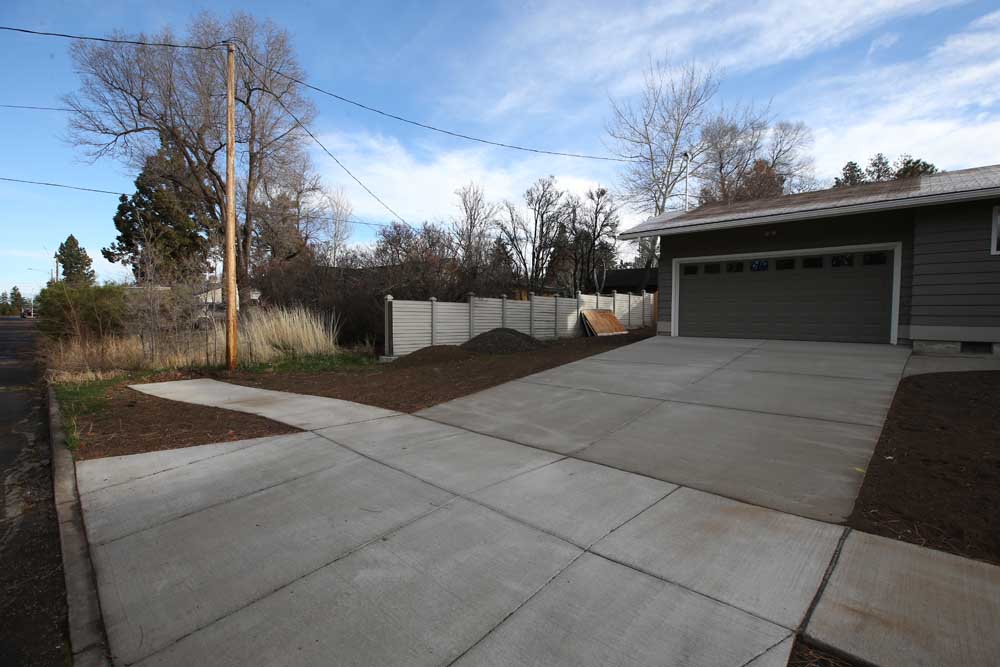Sidewalk changes coming to Bend City Council
Published 12:00 am Friday, February 2, 2018

- A sidewalk to nowhere on Bend's east side. (The Bulletin file photo)
Jake Woodruff’s home, like nearly all of the 80 homes in his Pinebrook neighborhood in southwest Bend, doesn’t have a sidewalk. But unless the City Council approves a development code change this month, he’ll be on the hook to build one before he can finish constructing an addition and detached garage.
Woodruff lives just a few hundred feet from Pinebrook Boulevard, which does have a sidewalk, and current Bend code requires homeowners within 600 feet of an existing sidewalk to build one whenever they undertake major renovations. A change scheduled for a public hearing Wednesday would allow homeowners to pay a fee for the city to build connecting sidewalks nearby, though not necessarily in front of their homes.
“The way it is now, there would be 200 feet, 400 feet with nothing and then a sidewalk in front of my house,” Woodruff said. “It just wouldn’t make sense.”
The change also would remove the 600-foot distance requirement, meaning that all homeowners who don’t have adjacent sidewalks would have to build one or pay a fee. The Central Oregon Builders Association opposes that part of the change and one city councilor wants to add a distance requirement back into the code.
Getting rid of the 600-foot cutoff makes the requirement fairer, Woodruff said.
“I don’t know why I would get dinged just for being closer to a sidewalk than anybody else,” Woodruff said.
Councilor Justin Livingston said Thursday he plans to propose an amendment to the code, re-inserting some sort of distance, though not necessarily 600 feet. That distance, according to city staff, is based on the length of city blocks in neighborhood grids created 40 or 50 years ago.
Some neighborhoods in southeast Bend, including the Kings Forest neighborhood, were designed without sidewalks and neighbors there don’t want them, Livingston said. Someone who lives in the middle of Kings Forest or Nottingham shouldn’t have to choose between building an unwanted sidewalk and paying a fee, he said.
“I have a hard time telling someone in there that you have to pay for a sidewalk,” he said.
The Central Oregon Builders Association supports having a fee in lieu of construction but wants to hold off on requiring all homeowners to build sidewalks until the city has a more strategic plan to install sidewalks where needed, said Karna Gustafson, vice president of government affairs at the association. Sidewalks create more impervious surfaces, interfering with drainage, and need to be shoveled and maintained. There may be better ways to ensure pedestrians can get through town safely than requiring sidewalks on both sides of every street, she said.
“We need to make sure we’re not putting sidewalks in just to have sidewalks,” she said.
Bend’s streets department already divides the city into eight regions and focuses street maintenance on one region each year. It’s a good model to use for sidewalks the city builds with proceeds from fees, City Engineer Ryan Oster said at a planning commission meeting last month.
“We’re going to try and piggyback that concept,” Oster said. “If our own streets department is coming through and they’re doing grinding and chip seal or something, then let’s take this $8,000 or $10,000 that we’ve gathered over the last eight years and build this missing block section of sidewalk that will get kids from the bus stop to the school.”
Fees won’t be set until later, but Oster said they’ll likely be around $8 per square foot. Now, a homeowner can typically pay a private developer around $4 or $5 a square foot, but the city pays closer to $12 or $13, Oster said.
To pay a fee instead of building a sidewalk as part of their renovations, homeowners would have to apply to the city and prove that topography, trees or utility boxes would make building one too expensive or that there aren’t, and are never likely to be, sidewalks in their vicinity. That encourages filling in sidewalks where they fit, Oster said.
“Somebody might be 605 feet away, but it could make sense that there should be a sidewalk here,” he said.
Filling in sidewalks where they’re most needed makes logical sense, said James Dorofi, chairman of the Old Farm District Neighborhood Association. The Old Farm District, which extends south from Reed Market Road between the parkway and 27th Street, includes Kings Forest, Vintage Faire and other neighborhoods that weren’t developed with sidewalks.
Those roads are wider, with slow-moving traffic, and pedestrians can get around on them without sidewalks, Dorofi said.
“People can easily walk and navigate the roads just fine,” Dorofi said. “Even somebody with an (Americans with Disabilities Act) issue can navigate just fine.”
Reed Market Road, the subject of a major city road project a few years ago, is also safer for pedestrians than 15th Street or Ferguson Road, Dorofi said. The city could use money from area residents who pay a fee instead of adding sidewalks to nowhere in front of their homes to create sidewalks on those larger streets.
“The southeast part of town became a place with islands of safety,” Dorofi said.
A public hearing on these changes, as well as one that would reduce the required amount of open space at apartment complexes near parks and create new standards for the Bend Central District, will take place during Wednesday’s 7 p.m. City Council meeting. Changes would take effect toward the end of March if approved.
— Reporter: 541-633-2160; jshumway@bendbulletin.com








